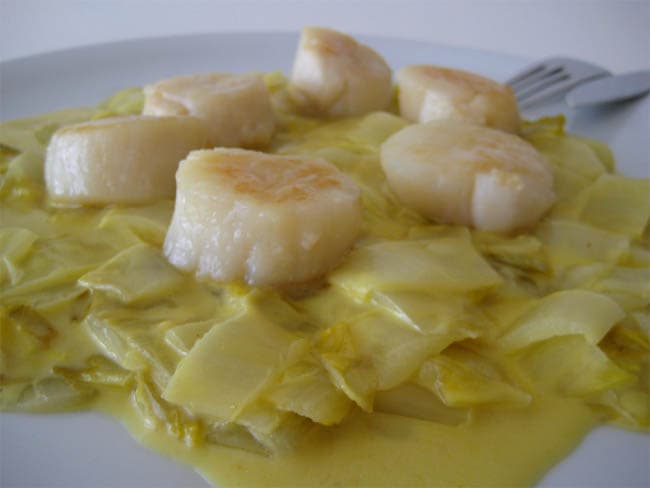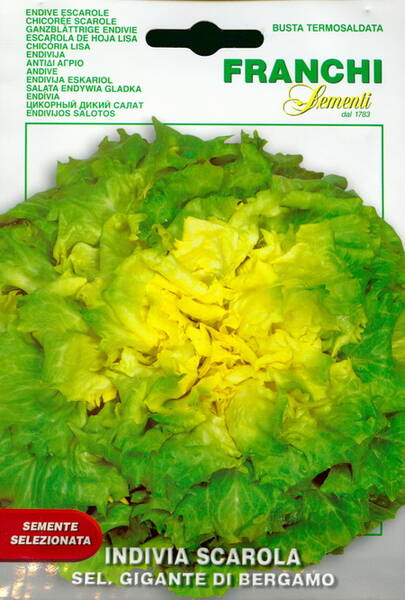Ex Tax: 1.14€
Mid-late variety: 85-90 days from germination.
Leafy form of chicory lettuce. Cultivation techniques are similar to growing ordinary lettuce.
1.0 g = 580-600 seeds.

* Endive and Escarole.
For a long time (almost a century), witloof was the only representative of the salad chicory family. Only relatively recently have breeders developed several more varieties: endive, resembling curly lettuce (also called "frisée" – from the French frisée – curly), and its variety with broader, lettuce-like leaves – escarole.
Endive and escarole are usually added to salads. They are more bitter in taste, so a sharp, piquant mustard dressing suits them well. Sugar also helps neutralize the bitterness, so chicory salads pair well with fruits such as pineapples, peaches, and pears.
Another variety of salad chicory – radicchio – resembles a small lettuce with dark red leaves threaded with cream-colored veins. When grown in complete darkness, its leaves acquire the color of pink marble. If light hits them, they develop green or copper-yellow spots. Radicchio tastes slightly bitter, but it contrasts pleasantly with green salads. It can be fried and blanched. After heat treatment, the leaves become dark green.
* Endive is an ancient plant native to India. Even before our era, it reached the Greeks via Ancient Egypt.
Even Pliny indicates that in his time endive was used as a salad plant and for making soup.
In the Roman Empire, similar forms of lettuce were widely grown mainly for medicinal purposes.
It is often mentioned in herbals of the Renaissance era.
It was cultivated quite widely in Tsarist Russia, but the bitter taste of the leaves and the peculiarity of agricultural technology gradually weakened interest in it.
Now this beautiful plant is found in gardens and vegetable patches very rarely, although growing it near large cities is very promising.
Endive is interesting because it provides the table with excellent salad greens in the autumn-winter period, when the supply of ordinary green vegetables is running out.
To remove the piquant bitterness, green leaves are boiled or kept in salted water for 20 minutes, washed, drained, and used for salads, side dishes, soups, stews, etc. The most important biological feature of endive is the rapid formation of a large rosette of leaves. In a short time, a powerful rosette weighing 300-400 g or more develops.
Endive leaves are elongated, deeply dissected with strongly curly edges. Leaf color varies from yellowish-green to dark green depending on the variety.
The plant's root is small, woody, and branched. With the onset of long days and elevated temperatures, the plants quickly form erect and branched flowering shoots with inflorescences consisting of numerous small lilac-colored flowers.
Surprisingly, this southern plant possesses exceptional cold resistance. At an early age, it tolerates frosts down to minus 4-6°C, which is very important when using it directly from the garden bed in late autumn. In fact, it can be taken from the vegetable garden until snow cover.
To have fresh salad even in late autumn, sowing is carried out in summer, and in autumn plants are moved with roots to a cold frame, which is covered with frames and mats when cold weather sets in.
For winter consumption of salad, plants are dug into moist sand in storage facilities. With good ventilation, they are preserved there for several months.
In winter, endive and escarole can be grown in greenhouses using the same agricultural techniques as for head lettuce.
Leaves of young plants (in the rosette phase) are used for food, most often as a salad, less often boiled or stewed; they are also used to decorate various dishes.
Consumption of chicory salads improves the activity of the digestive organs and the circulatory system.
Fresh, coarsely chopped leaves are eaten seasoned with vegetable oil, vinegar, or lemon juice with the addition of sugar, salt to taste, and sprinkled with parsley greens.
For 500 g of leaves, take 2 tablespoons of oil and 1 tablespoon of vinegar.
Stew endive and escarole over low heat for 30 minutes (750 g of chopped leaves and 60 g of butter, salt to taste), and pour lemon juice over them before serving.












